At a Glance
Complementing earlier research by the Congressional Budget Office, this report examines the availability and use of the Department of Defense’s (DoD’s) F-35 fighter aircraft. The F-35 has three variants: the F-35A, operated by the Air Force; the F-35B, operated by the Marine Corps; and the F-35C, operated by both the Navy and the Marine Corps.
CBO’s key findings are as follows:
- Growing Fleets. DoD currently operates about 450 F-35 aircraft and plans to operate about 2,500 of them by the mid-2040s. F-35s began operating in 2011.
- Aircraft Availability. The availability of F-35As and F-35Cs declined from 2015 to 2018 but increased in 2019 and 2020. (Availability is measured as the percentage of time an aircraft can be flown in training or on missions.) The availability of F-35Bs has been generally increasing since the aircraft began operating in 2012. In 2021, the availability rates of all three fleets of F-35s were higher than those of most of DoD’s other fighters. The F-35 fleets are much newer than most other fighters, and newer fleets typically have higher availability rates than older ones.
- Depot-Level Maintenance. Many of the oldest F-35s have spent long periods—totaling a year or more—undergoing depot-level maintenance (that is, in-depth maintenance beyond the capability of personnel where the aircraft operate), in part because DoD had to upgrade the earliest aircraft to updated operational standards. Newer F-35s may not require as much time undergoing depot-level maintenance, because they received the upgrades when they were manufactured.
- Annual Flying Hours. Total annual flying hours for each fleet of F-35s have generally increased along with fleet sizes. In recent years, F-35Cs have flown more hours per aircraft than have F-35As and F-35Bs. To date, all three fleets have flown fewer hours per aircraft per year than the average annual number of hours (over the service life of the fleet) anticipated in DoD’s plans.
- Lifetime Flying Hours. All three fleets of F-35s are a mix of new aircraft with few flying hours and aircraft with more than 1,000 lifetime flying hours.
- The Effects of the Coronavirus Pandemic. Although other types of DoD’s aircraft experienced increased availability and decreased flying hours during the initial months of the pandemic, there has been no consistent change in either measure for the F-35 fleets since the pandemic began.
Notes
Notes
All years referred to in this report are federal fiscal years, which run from October 1 to September 30 and are designated by the calendar year in which they end.
Numbers in the text and figures may not add up to totals because of rounding.
On the cover: Illustration of an F-35C.
In this report, the Congressional Budget Office analyzes the availability and use of the Department of Defense’s (DoD’s) F-35 fighter aircraft.1 Intended to replace older models of aircraft used by the Air Force, Marine Corps, and Navy, the F-35 has stealth capabilities that reduce the chance of detection by radar and heat-seeking missiles. There are three variants of the F-35, all of which are manufactured by Lockheed Martin and managed by the F-35 Joint Program Office:
The F-35A is operated by the Air Force and is intended to take off from and land at airfields.
The F-35B, operated by the Marine Corps, has a vertical lift fan and pivoting engine nozzle to allow vertical landing on and short takeoff from amphibious assault ships and airfields with runways that are short or rough.
The F-35C, operated primarily by the Navy (the Marine Corps also operates some F-35Cs), is designed to take off from and land on aircraft carriers. The F-35C uses a carrier’s catapult to assist its takeoff, and it lands on carriers by using a tailhook on the back of the aircraft to snag arresting cables.
F-35 Fleets
DoD’s fleets of F-35s have been growing since the aircraft were fielded in 2011. The department currently operates roughly twice as many F-35As as it does F-35Bs and F-35Cs combined. The oldest F-35 (an F-35A) first flew in July 2011, but many aircraft in each fleet have only recently entered service. A few aircraft have been destroyed in crashes. DoD plans to purchase a total of 1,763 F-35As, 353 F-35Bs, and 340 F-35Cs.2
Size of F-35 Fleets
Number of Aircraft

The Air Force currently operates about 300 F-35As, more than 100 F-35Bs, and about 50 F-35Cs. The total number of F-35s is about twice what it was in 2018.
Ages of F-35s
Number of Aircraft

The ages of F-35s range considerably, though almost half of them have not yet operated for three full years. (An aircraft in its first year of operation is considered new, having entered service during 2021; an aircraft in its fourth year of operation is three years old, having entered service during 2018.)
Availability Rates
CBO calculates aircraft availability rates by dividing the number of hours that aircraft are both mission capable and in the possession of operational squadrons by the total number of aircraft hours for the entire fleet, including aircraft undergoing depot-level maintenance or in storage. (A mission-capable aircraft can perform at least one of its primary missions but may not be able to perform all of them.)3
In their initial years, all three fleets of F-35s exhibited low availability rates, which rose thereafter. The availability of F-35As and F-35Cs declined from 2015 to 2018 but increased in 2019 and 2020. The availability of F-35Bs trended upward through 2020. In 2021, the F-35 fleets had higher availability rates than most of DoD’s other fighters and attack aircraft.4 The F-35 fleets are much newer than those other aircraft, and newer fleets typically have higher availability rates than older ones.
Availability Rates of F-35s
Percent

Over the past three years, availability rates of F-35s have tended to increase.
Availability Rates of DoD’s Fighters and Attack Aircraft in 2021
Percent
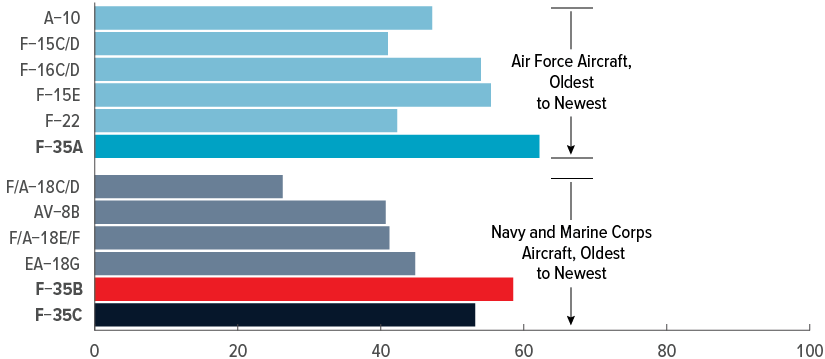
In 2021, the F-35s’ availability rates were higher than those of most of DoD’s other fighters and attack aircraft; the F-35s were also newer.
How CBO’s Measure of Aircraft Availability Differs From DoD’s Measure
CBO’s measure of aircraft availability counts all aircraft, including those undergoing depot-level maintenance (that is, in-depth maintenance beyond the capability of personnel where the aircraft operate). By contrast, DoD measures only the availability of aircraft in the possession of operating units and thus excludes from consideration aircraft undergoing depot-level maintenance or in long-term storage. DoD’s measure of availability is not adversely affected when an unusually large number of aircraft are undergoing depot-level maintenance, whereas CBO’s measure shows less aircraft availability.5
Differences Between DoD’s and CBO’s Measures of Availability of F-35s
Percent
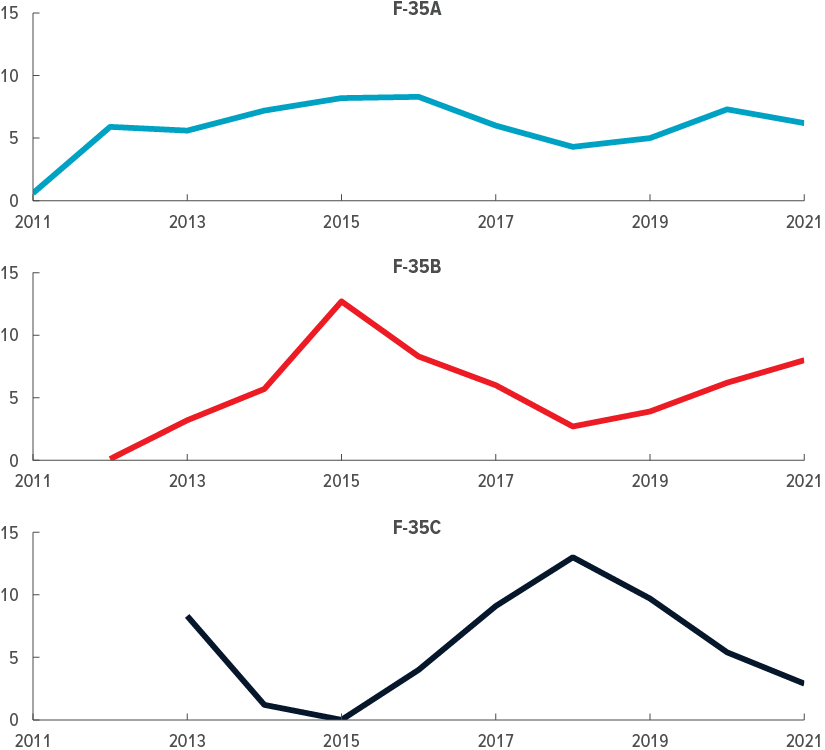
The availability of F-35As as measured by DoD has typically been about 6 percentage points higher than that measured by CBO.
DoD’s and CBO’s measures of availability for F-35Bs in 2015 differ by 13 percentage points (56 percent and 43 percent, respectively) because an average of 8 (out of 33) aircraft were in depot-level maintenance that year.
DoD’s and CBO’s measures of availability for F-35Cs in 2018 differ by 13 percentage points (54 percent and 41 percent, respectively) because an average of 8 (out of 28) aircraft were in depot-level maintenance that year.
Time Spent Undergoing Depot-Level Maintenance
The amount of time that F-35s have spent undergoing depot-level maintenance has varied, both by aircraft type and by cohort. Many of the oldest F-35s (those in their eighth year of operation or older) have spent a cumulative total of a year or more in depot-level maintenance. (Months spent in depot-level maintenance sometimes occur consecutively but are sometimes the result of separate visits over several years.) F-35s in their sixth or seventh year of operation have spent fewer months undergoing depot-level maintenance than the oldest F-35s have.
Months in Depot-Level Maintenance
Number of Aircraft
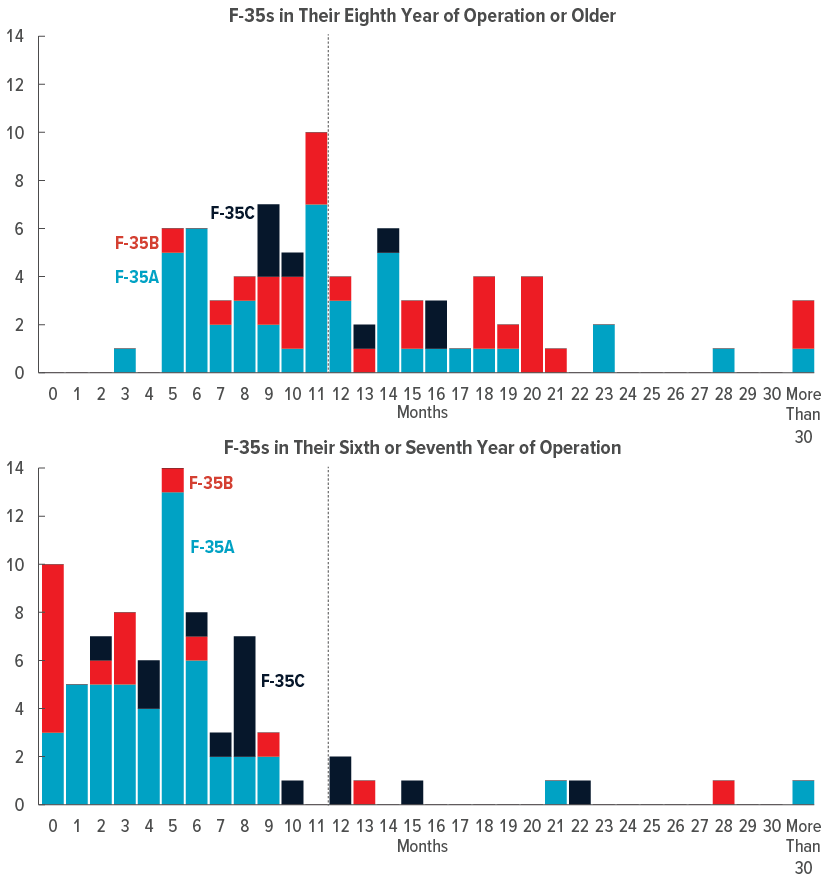
Forty-six percent of F-35s in their eighth year of operation or older have spent a year or more (cumulatively) undergoing depot-level maintenance, although there has been considerable variation among aircraft.
By contrast, only 10 percent of F-35s in their sixth or seventh year of operation have spent a year or more (cumulatively) undergoing depot-level maintenance—a difference partly attributable to the upgrades they received when they were manufactured.
Time Before First Lengthy Period Undergoing Depot-Level Maintenance
Of the 78 F-35s currently in their eighth year of operation or older, 73 (94 percent) have spent at least one four-month period undergoing depot-level maintenance. For 60 of those 73 aircraft, the first such lengthy period in depot-level maintenance occurred within four years of their first flights. Those older aircraft were brought to full operational standards by a “technology refresh” program. The 80 aircraft in their sixth or seventh year of operation may not require such lengthy periods undergoing depot-level maintenance, because, unlike the older F-35s, they received updates while being manufactured. To date, only 46 (58 percent) of those 80 aircraft have experienced a period of depot-level maintenance lasting at least four months. Moreover, personnel at maintenance depots have gained experience with F-35s, perhaps allowing maintenance to be completed more expeditiously.
The Oldest F-35s: Time Between First Flight and First Four-Month Period Undergoing Depot-Level Maintenance
Number of Aircraft
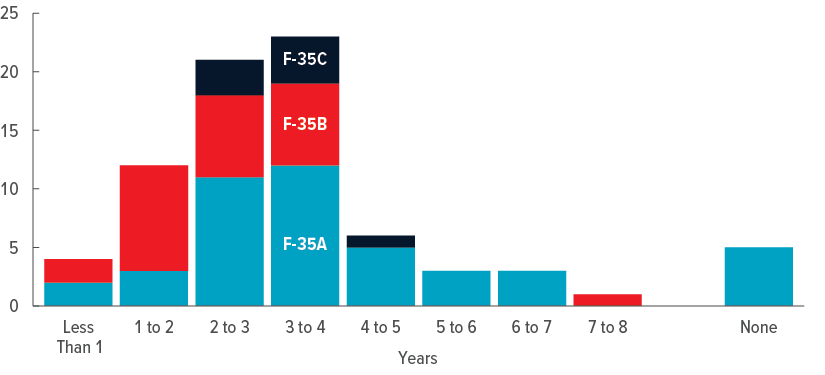
Most F-35s in their eighth year of operation or older spent four months or more undergoing depot-level maintenance between two and four years after they first flew.
Annual Flying Hours
Total annual flying hours for each fleet of F-35s have generally increased as the fleets have grown. In the early years of operation, flying hours per aircraft increased for all three fleets. In recent years, flying hours per aircraft among the F-35Cs have increased, whereas there is no clear trend in flying hours per aircraft for the F-35Bs. In 2021, F-35As experienced a downturn in flying hours per aircraft. The F-35 Selected Acquisition Report published in December 2019 states the average number of hours that each F-35 variant is planned to fly annually: 250 hours for F-35As; 300 hours for F-35Bs; and 316 hours for F-35Cs. None of the F-35 variants has yet reached those benchmarks.
Annual Flying Hours per Fleet
Thousands of Hours

Total annual flying hours for all three fleets of F-35s have generally increased as the fleets have grown. Total flying hours for the F-35As were only about 2 percent greater in 2021 than they were in 2020 (whereas the number of aircraft had increased by 21 percent).
Annual Flying Hours per Aircraft
Number of Hours
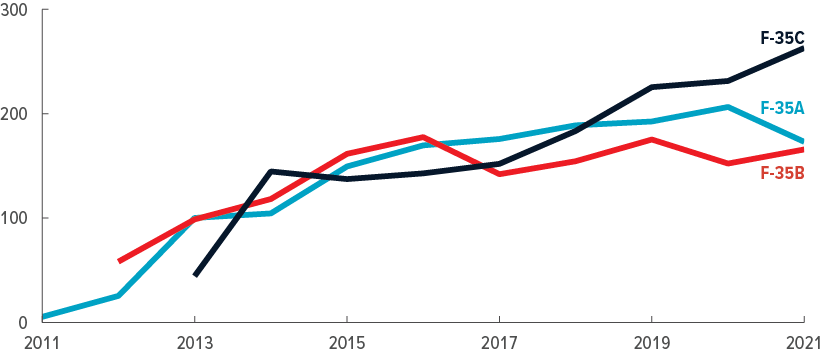
In recent years, F-35Cs have flown more hours per aircraft than have F-35As and F-35Bs.
Fleetwide Distributions of Lifetime Flying Hours
Lifetime flying hours vary considerably among all three fleets of F-35s. The F-35 with the most flying hours, an F-35A with tail number 11-5033, entered service in April 2014 and has flown 1,536 hours since then.
Distribution of Lifetime Flying Hours
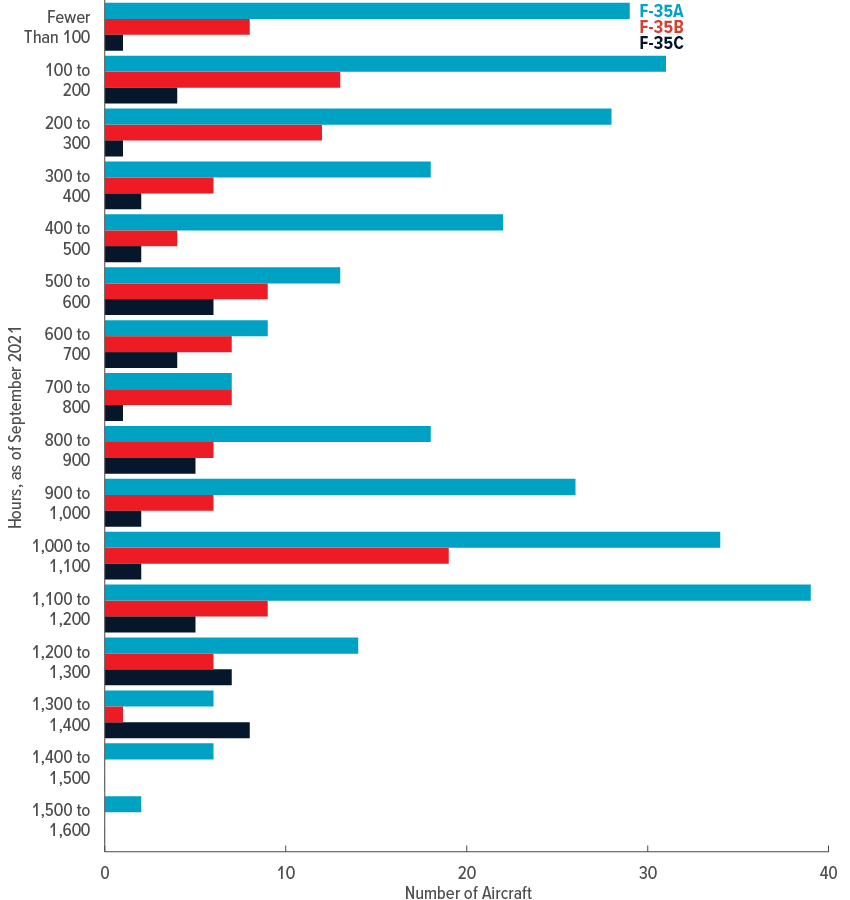
About one-third of the F-35s have flown more than 1,000 hours, including 101 F-35As, 35 F-35Bs, and 22 F-35Cs. More than a quarter of the F-35s have flown 300 hours or fewer.
Effects of the Coronavirus Pandemic
In an earlier analysis, CBO found that among aircraft operated by the Air Force, Marine Corps, and Navy (excluding the F-35), availability increased and flying hours decreased as a result of the pandemic—most markedly in April and May 2020.6 By contrast, the three fleets of F-35s show no consistent impact from the pandemic.
Quarterly Availability Rates of F-35 Fleets in 2020 and 2021
Percent

The three fleets’ quarterly availability rates have varied within the same ranges they were in before the onset of the pandemic in March 2020.
Quarterly Flying Hours per Aircraft in 2020 and 2021 in Relation to the Average for the Same Quarters From 2015 to 2019
Percent

Removing seasonal effects from the data, this figure compares flying hours during the same quarters before and after the start of the pandemic. For instance, flying hours per aircraft in the second quarter of calendar year 2020 (April to June 2020) are compared with an average of flying hours per aircraft in the second quarters of 2015, 2016, 2017, 2018, and 2019. F-35Cs flew more hours per aircraft after the onset of the pandemic than before it; F-35As and F-35Bs flew about the same number of hours per aircraft after the pandemic began as they did before.
1. In January 2022, CBO published Availability and Use of Aircraft in the Air Force and Navy (www.cbo.gov/publication/57433), but because it relied on data collected in the services’ standard data systems for aircraft availability, that report did not include the F-35. Data on the F-35’s availability and use are collected separately in Lockheed Martin’s Sustainment Performance Management System. The F-35 Joint Program Office provided those data to CBO for this report. The data are organized by month and cover the period from July 2011 (when F-35As were first fielded) to September 2021. Foreign militaries also operate F-35 variants; aircraft operated by foreign militaries are not analyzed here.
2. See Jeremiah Gertler, F-35 Joint Strike Fighter (JSF) Program, Report RL30563, version 83 (Congressional Research Service, January 14, 2022), https://go.usa.gov/xtF7S.
3. For a discussion of the full-mission-capable rates of F-35s, see Government Accountability Office, F-35 Sustainment: DOD Needs to Cut Billions in Estimated Costs to Achieve Affordability, GAO-21-439 (July 7, 2021), www.gao.gov/products/gao-21-439. The full-mission-capable rate is a more stringent measure of readiness than the mission-capable rate because it reflects the percentage of time during which an aircraft can perform all—not just one or more—of its tasked missions. The Government Accountability Office suggests that full-mission-capable rates “provide a clearer picture of the aircraft’s capabilities and the services’ return on investment.” That agency further states that “According to program officials, DOD is considering placing incentives on the full mission capable rate, rather than the mission capable rate, in future sustainment contracts.”
4. The data for aircraft other than F-35s come from the Air Force’s Reliability and Maintainability Information System and the Department of the Navy’s Decision Knowledge Programming for Logistics Analysis and Technical Evaluation system.
5. For a discussion of two alternative measures of aircraft availability, see Congressional Budget office, Availability and Use of Aircraft in the Air Force and Navy (January 2022), appendix, www.cbo.gov/publication/57433. However, mission-capable F-35s not undergoing depot-level maintenance have almost always logged flying hours, and F-35s have not yet been put into storage, so those alternative measures are less relevant to the fleets of F-35s.
6. See Congressional Budget Office, Availability and Use of Aircraft in the Air Force and Navy (January 2022), www.cbo.gov/publication/57433.
AppendixData Sources for Figures
Size of F-35 Fleets
Congressional Budget Office, using data from Lockheed Martin’s Sustainment Performance Management System.
Ages of F-35s
Congressional Budget Office, using data from Lockheed Martin’s Sustainment Performance Management System.
Availability Rates of F-35s
Congressional Budget Office, using data from Lockheed Martin’s Sustainment Performance Management System.
Availability Rates of DoD’s Fighters and Attack Aircraft in 2021
Congressional Budget Office, using data from Lockheed Martin’s Sustainment Performance Management System, the Air Force’s Reliability and Maintainability Information System, and the Department of the Navy’s Decision Knowledge Programming for Logistics Analysis and Technical Evaluation system.
Differences Between DoD’s and CBO’s Measures of Availability of F-35s
Congressional Budget Office, using data from Lockheed Martin’s Sustainment Performance Management System.
Months in Depot-Level Maintenance
Congressional Budget Office, using data from Lockheed Martin’s Sustainment Performance Management System.
The Oldest F-35s: Time Between First Flight and First Four-Month Period Undergoing Depot-Level Maintenance
Congressional Budget Office, using data from Lockheed Martin’s Sustainment Performance Management System.
Annual Flying Hours per Fleet
Congressional Budget Office, using data from Lockheed Martin’s Sustainment Performance Management System.
Annual Flying Hours per Aircraft
Congressional Budget Office, using data from Lockheed Martin’s Sustainment Performance Management System.
Distribution of Lifetime Flying Hours
Congressional Budget Office, using data from Lockheed Martin’s Sustainment Performance Management System.
Quarterly Availability Rates of F-35 Fleets in 2020 and 2021
Congressional Budget Office, using data from Lockheed Martin’s Sustainment Performance Management System.
Quarterly Flying Hours per Aircraft in 2020 and 2021 in Relation to the Average for the Same Quarters From 2015 to 2019
Congressional Budget Office, using data from Lockheed Martin’s Sustainment Performance Management System.
About This Document
This report was prepared at the request of the Chairman and Ranking Member of the Subcommittee on Readiness of the House Armed Services Committee. In keeping with the Congressional Budget Office’s mandate to provide objective, impartial analysis, the report makes no recommendations.
Edward G. Keating, R. Derek Trunkey, and Kathryn McGinnis prepared the report with guidance from David Mosher. David Arthur, Ron Gecan, Shannon Smith, and Natalie Tawil provided assistance. Eric J. Labs fact-checked the report. Timothy Conley of the RAND Corporation and J. J. Gertler, formerly of the Congressional Research Service, commented on an earlier draft. The assistance of external reviewers implies no responsibility for the final product; that responsibility rests solely with CBO.
Jeffrey Kling and Robert Sunshine reviewed the report. Scott Craver edited it, and R. L. Rebach created the graphics, illustrated the cover, and prepared the text for publication. The report is available at www.cbo.gov/publication/57842.
CBO seeks feedback to make its work as useful as possible. Please send comments to communications@cbo.gov.

Phillip L. Swagel
Director
April 2022


